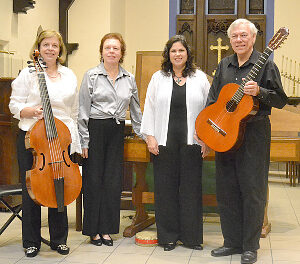Violinist Richard Luby thought outside the usual recital program box when he arranged the menu for his concert in Hill Hall on the University of North Carolina campus. His program opened with works by an eclectic American and a late Romantic Pole and finished with elegant pieces by Classical and Impressionist composers. Luby was ably accompanied by pianist Wonmin Kim. The piano lid was kept on the shortest stick. This was the first concert I had attended in Hill Hall since its overhaul. Alas, Hill Hall’s “celebrated” acoustical murkiness has not been lost. This afflicted the first two works played the most.
If ever a composer thought outside the box, it was certainly Charles Ives (1874-1954). The New England iconoclast was deeply influenced by the overlapping of sounds in space such as the sounds of different choirs singing different hymns at summer camp meetings or of several bands rehearsing different marches. This is central to his four Violin Sonatas and especially Sonata No. 4, “Children’s Day at the Camp Meeting.” Ives’ programmatic notes have survived for all of the sonatas except No. 2. About No. 4, he wrote, “at summer camp meetings… the children (more so the boys) would get marching and shouting the hymns.” Ives creates sonic collages, layering snatches of hymns or popular songs and often using rapidly changing rhythms. Wholly different passages for violin and piano are set against each other. The loud and driven outer two movements evoke the children’s rambunctiousness while the gentle slow middle movement evokes them in a serious mood. The hymn “Yes, Jesus Loves Me” is quoted in the second movement, and “At the River” is prominent in the third. Luby’s playing kept on top of every sudden twist and turn of the score, and his tone, somewhat nasal, was apt for it. The piano seemed a little too loud during the opening, but Kim quickly adjusted the dynamics.
Works by Polish composer Karol Szymanowski (1882-1937) used to be hard to find on records, much less in the concert hall. His violin Sonata in D minor, Op. 9, was composed in 1904 and premiered in Warsaw by violinist Paweł Kochański and pianist Artur Rubinstein on April 3, 1909. While it is a juvenile work, it already manifests Szymanowski’s melodic creativity and sensitivity to sound. He was inspired by the late violin sonatas of Brahms and the Franck Violin Sonata in A. Szymanowski reined in his romanticism in Op. 9, keeping to strict classical forms. Luby and Kim produced a full, warm sound, bringing out the work’s subtle harmonic shadings and, not least, its expressive, rich tone.
The second half of the concert was the most satisfying since it was dominated by music that demanded clarity and elegance. The works of Wolfgang Amadeus Mozart are at the very heart of the Classical repertory. His Violin Sonata in E-flat, K.481, is a towering masterpiece. The familiar four-note “Jupiter” Symphony theme appears in the sonata’s first movement development (used homophonically only) and reappears in the coda. The magnificent slow movement is one of the very few true Adagios Mozart wrote. Its harmonic language is a world apart. Classical equilibrium is restored by a wonderful set of variations in the last movement. Long time Chapel Hillians remember Luby as a major co-founder of the very active early music movement locally, in the 1980s. His playing was stylish with ideal phrasing. His bowing and fingering were precise in this music. Mozart, as ever was his wont, never provides musicians any cover for mistakes. Luby’s focused and mellow tone was welcome. Kim’s keyboard playing matched, with its seamless clarity and excellent dynamic balance.
While Maurice Ravel (1875-1937) is labeled an impressionist, there is nothing hazy or imprecise in his music. His Violin Sonata was composed between 1923 and 1927; the delay was due to his ill health. Ravel dedicated it to violinist Helene Jourdan-Morhange, but by the time of the sonata’s premiere, arthritis prevented her giving it. Violinist Georges Enesců and Ravel premiered it in Paris in May 1927. Ravel scrupulously respects the two instruments’ independence. The first movement is in traditional classical form, an allegretto with a continuous forward sweep. The wonderful second movement, “Blues,” uses bitonality and melodic figures prominent in 1920’s Blues. The finale is a brilliant Perpetuum mobile leading relentlessly to a blazing, intoxicated finish. Kim’s piano playing was wonderfully pointillistic: crystal-clear, and sensitive to the slightest shift of color or dynamics. Luby’s palette of tone and dynamics was remarkable and stylish. The myriad of pizzicatos he conjured up for the seductive “Blues” movement was endlessly delightful.











